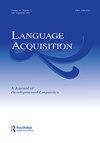Exploring syntactically encoded evidentiality
IF 1.3
3区 文学
0 LANGUAGE & LINGUISTICS
引用次数: 0
Abstract
ABSTRACT The most recent studies on the acquisition of evidentiality, be it morphologically or syntactically encoded, have argued that the comprehension lag detected is due to factors having to do with others’ authority or mental perspective, where “others” stands for other individuals involved in the experiment in various manners (e.g., the experimenter or someone in the props). However, these studies have yet to detect the age at which children eventually align with adults in comprehending the grammatical structure encoding the evidential interpretation when it is syntactically encoded. The comprehension study reported in this article has taken the aforementioned factors into consideration and has involved a large number of Greek-speaking children between second and fifth grades, along with an adult control group, to investigate syntactically encoded evidentiality. The results suggest that children align with adults in mapping source of evidence to sentence type during fourth grade, when they are 9 years old or older, suggesting that there should be additional factors behind the delayed comprehension of evidentiality. It is argued that these factors are mainly grammatical, and, most importantly, they arise to a larger extent in languages that encode evidentiality in the syntax探索句法编码证据
最近关于证据性获得的研究,无论是形态学还是句法编码,都认为所检测到的理解滞后是由于与他人的权威或心理视角有关的因素,其中“他人”代表以各种方式参与实验的其他个体(例如,实验者或道具中的某人)。然而,这些研究尚未检测到儿童在理解编码证据解释的语法结构时最终与成人一致的年龄。本文报道的综合研究考虑了上述因素,并涉及大量二年级至五年级讲希腊语的儿童,以及成人对照组,以调查句法编码证据。结果表明,儿童在四年级时,当他们9岁或更大时,在将证据来源映射到句子类型方面与成人一致,这表明证据性理解延迟的背后应该有其他因素。本文认为,这些因素主要是语法上的,而且,最重要的是,这些因素在语法中编码证据性的语言中出现的程度更大
本文章由计算机程序翻译,如有差异,请以英文原文为准。
求助全文
约1分钟内获得全文
求助全文
来源期刊

Language Acquisition
Multiple-
CiteScore
2.30
自引率
8.30%
发文量
20
期刊介绍:
The research published in Language Acquisition: A Journal of Developmental Linguistics makes a clear contribution to linguistic theory by increasing our understanding of how language is acquired. The journal focuses on the acquisition of syntax, semantics, phonology, and morphology, and considers theoretical, experimental, and computational perspectives. Coverage includes solutions to the logical problem of language acquisition, as it arises for particular grammatical proposals; discussion of acquisition data relevant to current linguistic questions; and perspectives derived from theory-driven studies of second language acquisition, language-impaired speakers, and other domains of cognition.
 求助内容:
求助内容: 应助结果提醒方式:
应助结果提醒方式:


